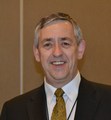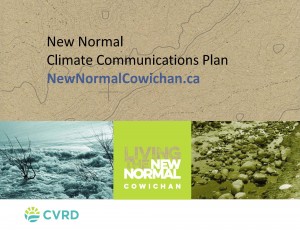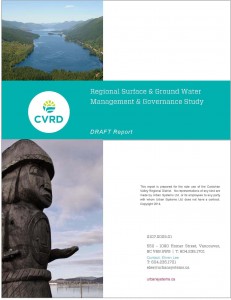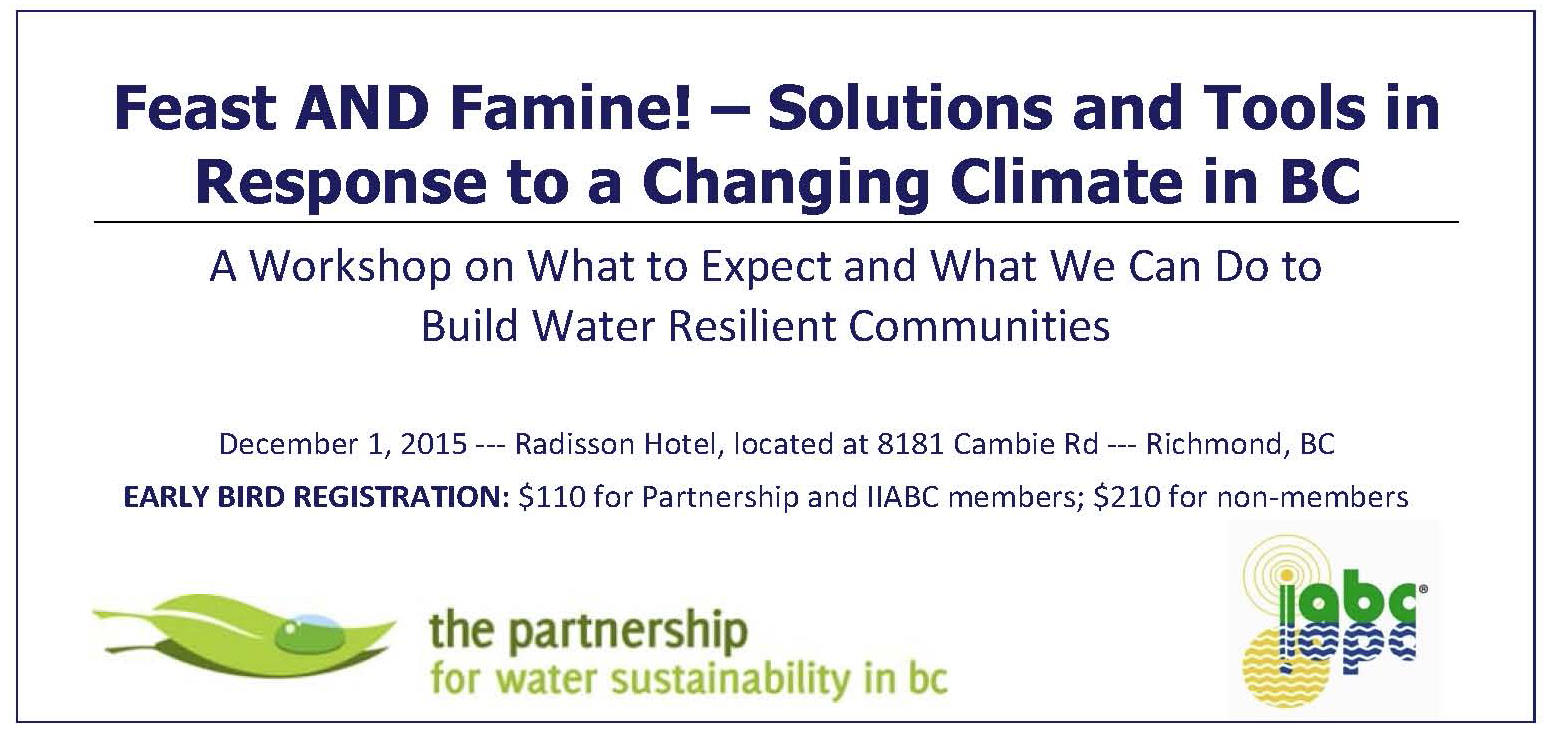Our Climate is Changing: Moving Towards a Water Balance Culture in the Cowichan Region on the east coast of Vancouver Island
Note to Reader:
On December 1, 2015 the Partnership for Water Sustainability in British Columbia (“the Partnership”) and the Irrigation Industry Association of British Columbia (“IIABC”) are again joining forces to co-host a workshop that is topical. The 2015 Drought is front and centre.
To download a copy of the Program Overview, click on Feast AND Famine! – Solutions and Tools in Response to a Changing Climate. It provides a detailed picture of what to expect in each of the four modules that comprise the workshop day. Module B deals with this question: How are local governments responding to a changing climate?

SKUTZ FALLS ON THE COWICHAN RIVER: What the Water Balance problem in the Cowichan looks like……Fall 2006 – too much water!…Summer 2006 – too little water!
“The Cowichan Region is advancing processes and developing products that are the foundation for a future Water Sustainability Plan,” says CVRD’s Keith Lawrence
The summer dry season has extended on both ends and BC communities can no longer count on a predictable snowpack and reliable rain to maintain a healthy water balance in their watersheds. Annual volumes of water entering and exiting regions are not necessarily changing; instead, what is changing is how and when water arrives – it is feast AND famine!
The Cowichan Region is a provincial leader in demonstrating how local government action can influence Water Balance outcomes. Cowichan experience will be featured at the Feast AND Famine Workshop on December 1, 2015.
Our Climate is Changing & Adaptation is Local
“According to Bob Sandford, keynote speaker for our Feast AND Famine Workshop (December 1st), the drought that extended this past winter, spring and summer from Vancouver Island to Manitoba and from Mexico to the Yukon is an indicator that Western North America may be crossing an invisible threshold into a  different hydro-meteorological regime,” notes Mike Tanner, Workshop Chair.
different hydro-meteorological regime,” notes Mike Tanner, Workshop Chair.
“Adaptation is local in application. Hence, this workshop on responding to a changing climate is about solutions and tools that are being developed in BC through collaboration to support practitioners and decision makers to take action at a local level.”
“At the Feast AND Famine Workshop, Kate Miller and Keith Lawrence will tell the story of what the Cowichan Valley Regional District (CVRD) is doing. Located on the east coast of Vancouver Island, the Cowichan region is an incubator for Water Balance approaches that can be replicated elsewhere in the Georgia Basin and beyond.”
Communicating the ‘New Normal’
“ Summer drought and winter flooding are the ‘new normal’ in the Cowichan region, and are putting water supply and the regional ecosystem under extreme stress. To foster long-term, strategic water preparedness the CVRD has launched a website that is intended to provide the community with easy, clear information and tools that make adapting to the ‘new normal’ easier,” explains Kate Miller, Manager of Environmental Services, CVRD Engineering & Environmental Services Department.
Summer drought and winter flooding are the ‘new normal’ in the Cowichan region, and are putting water supply and the regional ecosystem under extreme stress. To foster long-term, strategic water preparedness the CVRD has launched a website that is intended to provide the community with easy, clear information and tools that make adapting to the ‘new normal’ easier,” explains Kate Miller, Manager of Environmental Services, CVRD Engineering & Environmental Services Department.
 “The New Normal Cowichan initiative illustrates what putting ‘water balance thinking’ into action looks like from a communications perspective. The branding for the New Normal uses images and words that inform and educate, with a focus on practical actions that emphasize what is possible: Drought Smart, Flood Smart and Smart Tools.”
“The New Normal Cowichan initiative illustrates what putting ‘water balance thinking’ into action looks like from a communications perspective. The branding for the New Normal uses images and words that inform and educate, with a focus on practical actions that emphasize what is possible: Drought Smart, Flood Smart and Smart Tools.”
Changing How Decisions are Made
 “Recurring region-wide consequences of water-related challenges have also prompted regional action to develop governance structures and processes to make the connections between high-level decision making and actions on the ground. The Regional Surface and Ground Water Management and Governance Study identified co-governance with First Nations as a primary condition for success in managing regional water resources,” continues Keith Lawrence, Senior Environmental Analyst in the CVRD Engineering & Environmental Services Department .
“Recurring region-wide consequences of water-related challenges have also prompted regional action to develop governance structures and processes to make the connections between high-level decision making and actions on the ground. The Regional Surface and Ground Water Management and Governance Study identified co-governance with First Nations as a primary condition for success in managing regional water resources,” continues Keith Lawrence, Senior Environmental Analyst in the CVRD Engineering & Environmental Services Department .
 “It is proposed to apply whole watershed thinking and follow a risk-based approach to decision-making and management across the region. Currently, over 60 distinct organizations – including First Nations, improvement districts, government agencies, NGOs and industry – play a governance, management, and stewardship of water resources in the Cowichan Region. Coordination between these organizations is key as we face the pressures of climate change and population growth on our resources.”
“It is proposed to apply whole watershed thinking and follow a risk-based approach to decision-making and management across the region. Currently, over 60 distinct organizations – including First Nations, improvement districts, government agencies, NGOs and industry – play a governance, management, and stewardship of water resources in the Cowichan Region. Coordination between these organizations is key as we face the pressures of climate change and population growth on our resources.”
To Learn More:
Click on Regional Surface and Ground Water Management and Governance Study to download a copy of the Draft Report.


